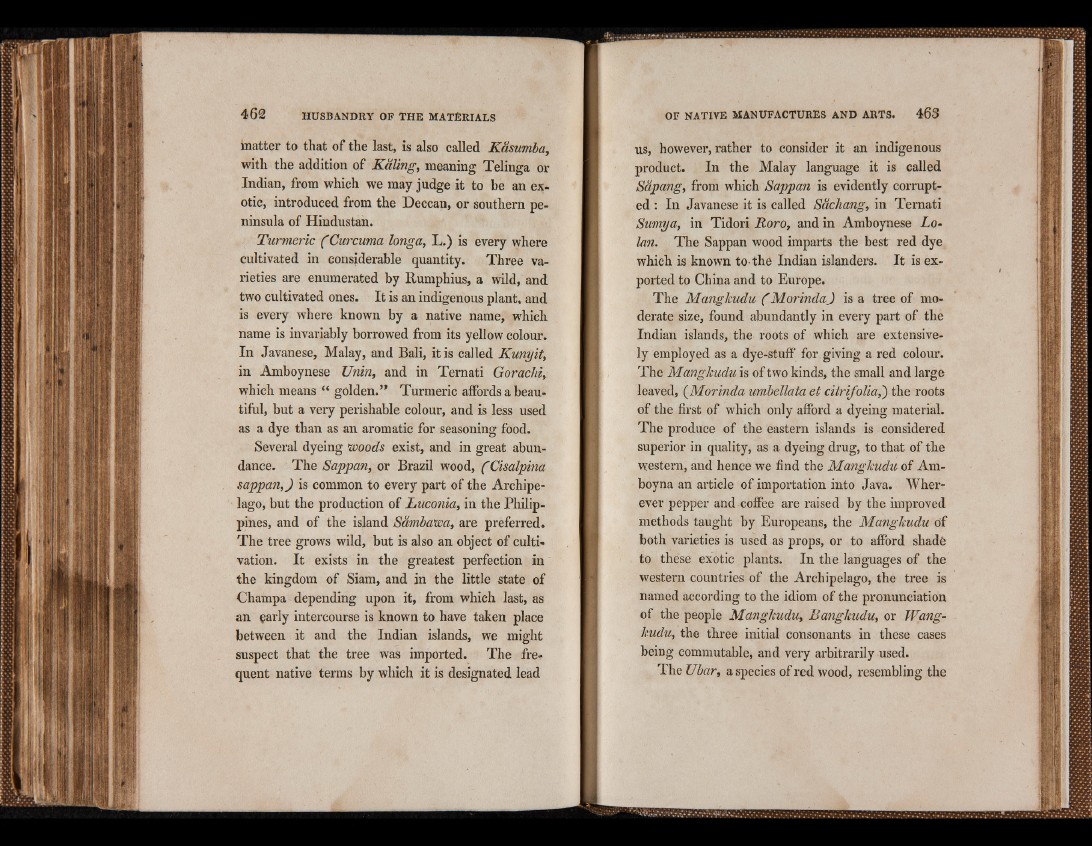
inatter to that of the last, is also called Kasumba,
with the addition of Kaling, meaning Telinga or
Indian, from which we may judge it to be an exotic,
introduced from the Deccan, or southern peninsula
of Hindustan.
Turmeric ( Curcuma longa, L.) is every where
cultivated in considerable quantity. Three varieties
are enumerated by Rumphius, a wild, and
two cultivated ones. It is an indigenous plant, and
is every where known by a native name, which
name is invariably borrowed from its yellow colour.
In Javanese, Malay, and Bali, it is called Kunyit,
in Amboynese Unin, and in Ternati Gorachi,
which means “ golden.’* Turmeric affords a beautiful,
but a very perishable colour, and is less used
as a dye than as an aromatic for seasoning food.
Several dyeing woods exist, and in great abundance.
The Sappan, or Brazil wood, ( Cisalpina
sappan, ) is common to every part of the Archipelago,
but the production of JLuconia, in the Philippines,
and of the island Sambawa, are preferred.
The tree grows wild, but is also an object of cultivation.
It exists in the greatest perfection in
the kingdom of Siam, and in the little state of
Champa depending upon it, from which last, as
an early intercourse is known to have taken place
between it and the Indian islands, we might
suspect that the tree was imported. The frequent
native terms by which it is designated lead
us, however, rather to consider it an indigenous
product. In the Malay language it is called
Sâpang, from which Sappan is evidently corrupted
: In Javanese it is called Sâchang, in Ternati
Sumy a, in Tidori Roro, and in Amboynese Lo-
lan. The Sappan wood imparts the best red dye
which is known to-thé Indian islanders. It is exported
to China and to Europe.
The Mangkudu ( Morinda) is a tree of moderate
size, found abundantly in every part of the
Indian islands, the roots of which are extensively
employed as a dye-stuff for giving a red colour.
The Mangkudu is of two kinds, the small and large
leaved, (Morinda umbellata et citrifolia,') the roots
of the first of which only afford a dyeing material.
The produce of the eastern islands is considered
superior in quality, as a dyeing drug, to that of the
western, and hence we find the Mangkudu of Am-
boyna an article of importation into Java. Wherever
pepper and coffee are raised by the improved
methods taught by Europeans, the Mangkudu of
both varieties is used as props, or to afford shade
to these exotic plants. In the languages of the
western countries of the Archipelago, the tree is
named according to the idiom of the pronunciation
of the people Mangkudu, Banglcudu, or Wang-
kudu, the three initial consonants in these cases
being commutable, and very arbitrarily used.
The Ubar, a species of red wood, resembling the